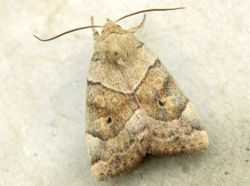Dun-bar
| The Dun-bar | |
|---|---|
 | |
| Scientific classification | |
| Kingdom: | Animalia |
| Phylum: | Arthropoda |
| Class: | Insecta |
| Order: | Lepidoptera |
| Family: | Noctuidae |
| Genus: | Cosmia |
| Species: | C. trapezina |
| Binomial name | |
| Cosmia trapezina (Linnaeus, 1758) | |
The Dun-bar (Cosmia trapezina) is a moth of the family Noctuidae. It is a common Palearctic species. The species occurs throughout almost the whole of Europe. In the North, the range extends to Middle Fennoscandia, in the East to the Urals. The species occurs in North Africa, Asia minor, Syria, Iraq, Iran, Caucasus, Central Asia to China, Korea and Japan (subspecies C. t. exigua (Butler, 1881)). It rises in the Alps up to 1600 m.
- See glossary for terms used
This is a very variable species, both in size (wingspan 28–38 mm) and colour. The ground colour of the forewings varies from pale buff to dark or reddish brown with three narrow fascia. The area between the inner two fascia is sometimes much darker than the surrounding ground colour and is marked with stigmata, often quite indistinct. Melanic forms occasionally occur. The hindwings vary from pale cream to dingy brown. This moth flies at night from July to September and is attracted to light and sugar and sometimes to nectar-rich flowers.
The larva is green with yellow lines and black and white spots. It feeds on a variety of plants, chiefly trees and shrubs (see list below) and also on the larvae of other Lepidoptera species, even occasionally its own species. The species overwinters as an egg.
- ^ The flight season refers to the British Isles. This may vary in other parts of the range.
Recorded food plants
- Acer - Maple
- Betula - Birch
- Corylus - Hazel
- Crataegus - Hawthorn
- Hippophae - Sea-buckthorn
- Lilium - Lily
- Malus - Apple
- Prunus
- Pyrus - Pear
- Quercus - Oak
- Rhamnus - Buckthorn
- Rhododendron
- Ribes - Currant
- Rubus
- Salix - Willow
- Sorbus - Rowan
- Tilia - Lime
- Ulmus - Wych Elm
See.[1]
References
- Chinery, Michael Collins Guide to the Insects of Britain and Western Europe 1986 (Reprinted 1991)
- Skinner, Bernard Colour Identification Guide to Moths of the British Isles 1984
External links
| Wikimedia Commons has media related to Cosmia trapezina. |
- Lepiforum
- Funet Taxonomy
- Fauna Europaea